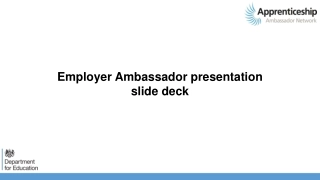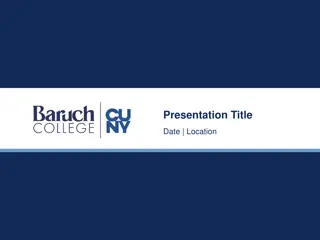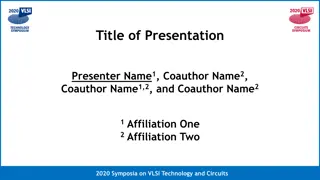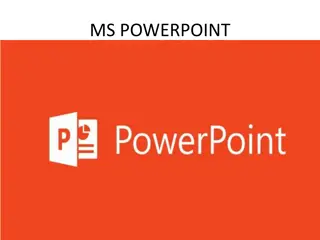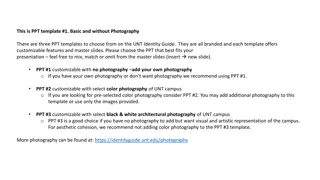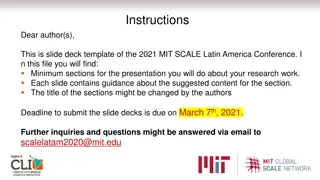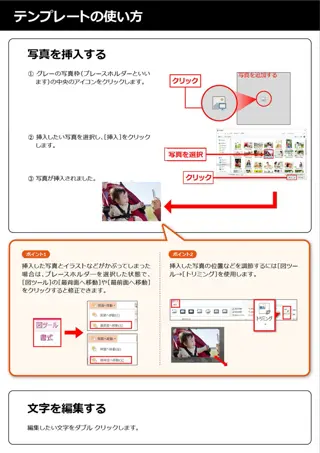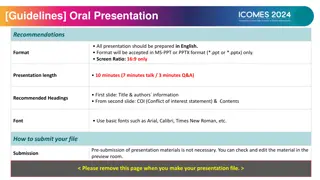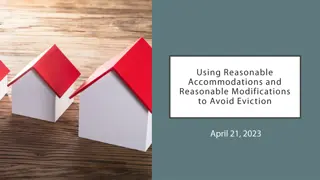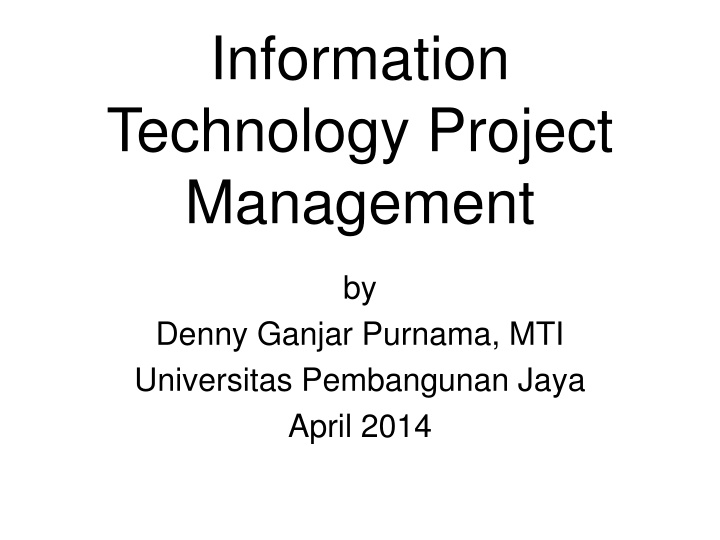
IT Project Management Essentials and Methodologies
Explore the foundational concepts of Information Technology Project Management, including methodologies, phases, and tools. Learn about project initiation, planning, execution, control, and evaluation for successful IT project completion and organizational value.
Download Presentation

Please find below an Image/Link to download the presentation.
The content on the website is provided AS IS for your information and personal use only. It may not be sold, licensed, or shared on other websites without obtaining consent from the author. If you encounter any issues during the download, it is possible that the publisher has removed the file from their server.
You are allowed to download the files provided on this website for personal or commercial use, subject to the condition that they are used lawfully. All files are the property of their respective owners.
The content on the website is provided AS IS for your information and personal use only. It may not be sold, licensed, or shared on other websites without obtaining consent from the author.
E N D
Presentation Transcript
Information Technology Project Management by Denny Ganjar Purnama, MTI Universitas Pembangunan Jaya April 2014
Chapter 2 Conceptualizing and Initializing The IT Project (Business Case)
Learning Objectives Define what a methodology is and describe the role it serves in IT projects. Identify the phases and infrastructure that makes up the IT project methodology. Develop and apply the concept of a project s measurable organizational value (MOV). Describe and be able to prepare a business case. Distinguish between financial models and scoring models. Describe the project selection process as well as the Balanced Scorecard approach.
Methodology A strategic level plan for managing and controlling IT projects. A template for initiating, planning and developing an information system. Recommends: phases deliverables processes tools knowledge areas Must be flexible and include best practices learned from experiences over time.
Phases Phase 1: Conceptualize and Initialize Phase 2: Develop the Project Charter and Detailed Project Plan defined in terms of project s: scope schedule budget quality objectives
Phases continued Phase 3: Execute and Control the Project using approach such as the SDLC Phase 4: Close Project Phase 5: Evaluate Project Success Post mortem by project manager and team of entire project Evaluation of team members by project manager Outside evaluation of project, project leader and team members Evaluate project s organizational value
IT Project Management Foundation Project Management Processes Initiating processes Planning processes Executing processes Controlling processes Closing processes Project Objectives
IT Project Management Foundation Tools - e.g. CASE, Visio, Microsoft Project, etc Infrastructure Organizational Infrastructure Project Infrastructure Project Environment Roles and Responsibilities of team members Processes and Controls Technical Infrastructure Project Management Knowledge Areas
The Business Case Definition of Business Case: an analysis of the organizational value, feasibility, costs, benefits and risks of the project plan. Attributes of a good Business Case Details all possible impacts, costs, benefits Clearly compares alternatives Objectively includes all pertinent information Systematic in terms of summarizing findings
Process for Developing the Business Case
Developing the Business Case Step 1: Select the Core Team Advantages: Credibility Alignment with organizational goals Access to the real costs Ownership Agreement Bridge building
Developing the Business Case Step 2: Define Measurable Organizational Value (MOV) - the project s overall goal.
Measurable Organizational Value (MOV) The project s goal Measure of success Must be measurable Provides value to the organization Must be agreed upon Must be verifiable at the end of the project Guides the project throughout its life cycle Should align with the organization s strategy and goals
Process for Developing the MOV 1. Identify the desired area of impact (dampak area yg diinginkan) Potential Areas: Strategic Customer Financial Operational Social
Process for Developing the MOV 2. Identify the desired value of the IT project (Nilai-nilai yg diinginkan) Organizational Value: Better? Faster? Cheaper? Do More? (growth)
Process for Developing the MOV 3. Develop an Appropriate Metric (metrik yg tepat) Should it increase or decrease? Metrics: Money ($ ) Percentage (%) Numeric Values
Process for Developing the MOV 4. Set a time frame for achieving the MOV When will the MOV be achieved?
Process for Developing the MOV 5. Verify and get agreement from the project stakeholders Project manager and team can only guide the process
Process for Developing the MOV 6. Summarize the MOV in a clear, concise statement or table. This project will be successful if _________________. MOV: The B2C project will provide a 20% return on investment and 500 new customers within the first year of its operation
Year MOV 20% return on investment 500 new customers 1 25% return on investment 1,000 new customers 2 3 30% return on investment 1,500 new customers Example MOV Using Table Format
Project Goal ? Install new hardware and software to improve our customer service to world class levels. versus Respond to 95% of our customers inquiries within 90 seconds with less than 5% callbacks about the same problem.
A Really Good Goal Our goal is to land a man on the moon and return him safely by the end of the decade. John F. Kennedy
Developing the Business Case Step 3: Identify Alternatives Base Case Alternative Possible Alternative Strategies Change existing process without investing in IT Adopt/Adapt systems from other organizational areas Reengineer Existing System Purchase off-the-shelf Applications package Custom Build New Solution
Developing the Business Case Step 4: Define Feasibility and Asses Risk Economic feasibility Technical feasibility Organizational feasibility Other feasibilities Risk focus on : Identification Assessment Response
Developing the Business Case Step 5: Define Total Cost of Ownership Direct or Up-front costs Ongoing Costs Indirect Costs
Developing the Business Case Step 6: Define Total Benefits of Ownership Increasing high-value work Improving accuracy and efficiency Improving decision-making Improving customer service
Developing the Business Case Step 7: Analyze Alternatives using financial models and scoring models Payback : Payback Period = Initial Investment Net Cash Flow = $100,000 $20,000 = 5 years
Developing the Business Case Break Even : Materials (putter head, shaft, grip, etc.) $12.00 Labor (0.5 hours at $9.00/hr) $ 4.50 Overhead (rent, insurance, utilities, taxes, etc.) $ 8.50 Total $25.00 If you sell a golf putter for $30.00 and it costs $25.00 to make, you have a profit margin of $5.00: Breakeven Point = Initial Investment / Net Profit Margin = $100,000 / $5.00 = 20,000 units
Developing the Business Case Return on Investment : Project ROI =(total expected benefits total expected costs) total expected costs = ($115,000 - $100,000) $100,000 = 15%
Developing the Business Case Net Present Value : Year 0 Year 1 Year 2 Year 3 Year 4 Total Cash Inflows $0 $150,000 $200,000 $250,000 $300,000 Total Cash Outflows $200,000 $85,000 $125,000 $150,000 $200,000 Net Cash Flow ($200,000) $65,000 $75,000 $100,000 $100,000 NPV = -I0 + (Net Cash Flow / (1 + r)t) Where: I = Total Cost or Investment of the Project r = discount rate t = time period
Developing the Business Case Net Present Value : Discounted Cash Flow Time Period Calculation ($200,000) ($200,000) Year 0 $65,000/(1 + .08)1 $60,185 Year 1 $75,000/(1 + .08)2 $64,300 Year 2 $100,000/(1 + .08)3 $79,383 Year 3 $100,000/(1 + .08)4 $73,503 Year 4 Net Present Value (NPV) $77,371
Weight Alternative A 2 3 2 Alternative B Alternative C Criterion 15% 10% 15% 4 5 4 10 10 10 ROI Payback Financial NPV Alignment with strategic objectives 10% 3 5 8 Organizational Likelihood of achieving project s MOV Availability of skilled team members 10% 2 6 9 5% 5 5 4 5% 5% 5% 4 5 3 6 7 5 7 6 5 Maintainability Project Time to develop Risk Customer satisfaction Increased market share 10% 2 4 9 External 10% 2 5 8 100% 2.65 4.85 8.50 Total Score Notes: Risk scores have a reverse scale i.e., higher scores for risk imply lower levels of risk
Developing the Business Case Step 8: Propose and Support the Recommendation
Project Selection and Approval The IT Project Selection Process The Project Selection Decision IT project must map to organization goals IT project must provide verifiable MOV Selection should be based on diverse measures such as tangible and intangible costs and benefits various levels throughout the organization
Reasons Balanced Scorecard Approach Might Fail Non-financial variables incorrectly identified as primary drivers Metrics not properly defined Goals for improvements negotiated not based on requirements No systematic way to map high-level goals Reliance on trial and error as a methodology No quantitative linkage between non-financial and expected financial results
MOV and the Organizations Scorecard


